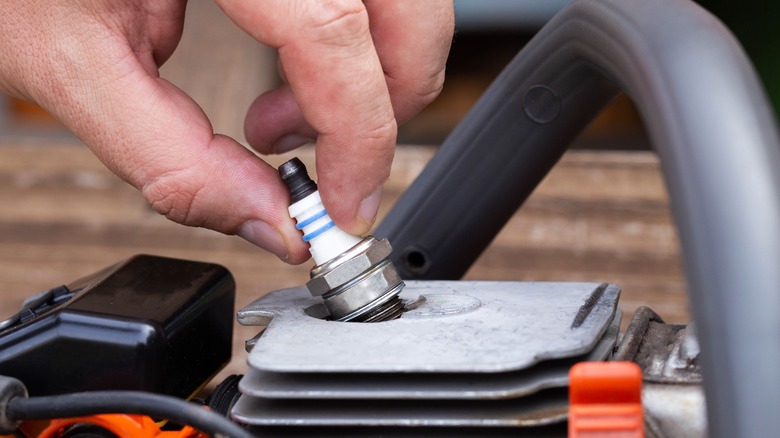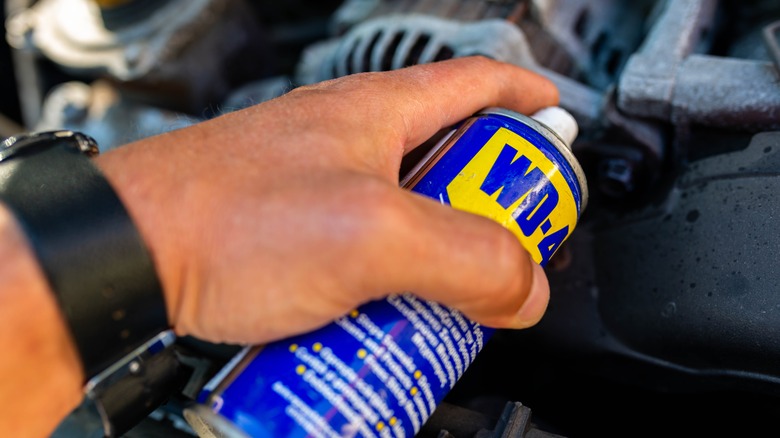A Household Staple Will Make Removing Spark Plugs A Breeze
If you own power equipment, ranging from a lawn mower to a car and anything in between, you probably know that a clean, functioning spark plug is a key to making the starting process a breeze. The spark plug provides a flash of electricity that ignites the fuel in a combustion engine. Occasionally, you will need to remove the spark plug for cleaning or replacement. Because it screws into its socket and has a nut on it, removing it should go easily. However, if the spark plug has corrosion or other buildup on it, it may not want to pop loose from the socket. One of the best ways to loosen a stuck spark plug is by spraying some WD-40 on it. In fact, NASCAR mechanics often use this hack to help them speed up the work on their car engines.
We've provided many tips for using WD-40 at home, as this product is one of the most versatile options for solving a multitude of problems. Around the house, it will clean scuff marks, remove stubborn stains, stop a squeaky door hinge, condition leather shoes and furniture, and deter wasps from building nests. Originally, though, scientists invented WD-40 several decades ago as a solvent designed to prevent rust on missiles. By using WD-40 to help you loosen a corroded or rusted spark plug that's locked in its socket, you are actually using this solvent for something closer to its original purpose. Here's how to do it.
How to remove a stuck spark plug with WD-40
Start by trying to remove the spark plug without spraying WD-40. Always use a special socket wrench that is made to fit the length and diameter of the spark plug. This tool greatly simplifies the process, especially in tough-to-reach areas of the engine. Some people place the tool on the end of a traditional socket wrench to gain a bit more length and leverage. Disconnect the terminals from the battery and remove the spark plug wire that connects to the ignition system before turning the wrench counterclockwise.
If you simply can't make the spark plug budge, don't force it. You could break it in half if you use too much force, potentially creating a significant repair bill or an extremely difficult DIY removal process. Instead of forcing it, spray some WD-40 around the base so it can penetrate the socket. If there's quite a bit of buildup around the top of the socket, you can spray the WD-40 in this area before wiping away the grime. Let the solvent sit for a few minutes and then try loosening it with the wrench again. You may have to repeat this process a few times or allow the WD-40 to sit overnight to loosen it. Once the spark plug is out, you can spray WD-40 directly into the spark plug hole to lubricate it. This should reduce the buildup of carbon and corrosion, making it easier to unscrew it next time.
Why does a spark plug get stuck in the socket?
One of the most common mistakes people make when buying a lawn mower is forgetting to perform regular maintenance on the machine. If it has a combustion engine, it needs maintenance to keep it in prime condition. Part of the maintenance schedule should include checking the spark plug and replacing or cleaning it as needed. However, if you forget to do this for a couple of years, you may find that it's impossible to unscrew the spark plug out of the socket and remove it. Whether working on a car, lawn mower, or another device with a combustion engine, the spark plug could become stuck in the socket for a few different reasons.
Often, corrosion can affect the threads of the spark plug, causing rust that leaves it stuck in the socket. If it wasn't installed tightly enough in the socket, a buildup of carbon can reach the threads, creating a mess that leaves it stuck in place. Regular maintenance reduces this possibility. The good news is that you can use WD-40 to clean a dirty spark plug, giving it a longer lifespan and making it easier to install and remove. Spray some WD-40 onto a microfiber cloth and rub it onto the threads. If it is highly corroded, spray WD-40 directly onto the threads. Let it sit for a few minutes before wiping it.


